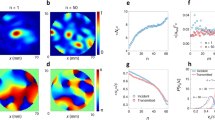Summary
The theory of energy propagation in dispersive media formulated by Brillouin is generalized and extended by taking into account energy attenuation or energy growth during the transmission process. Because of the exponential decay due to attenuation, the concept of propagation velocity of an electromagnetic disturbance can now be shown to have a physical meaning even if there is absorption, and in such a case the velocity of the disturbance is represented by the velocity of the point at which it attains its maximum intensity. Expressions are obtained for the energy density and the energy flow in an absorbing medium, and it is shown that the propagation velocity (a kinematic concept) is equal to the velocity of the energy transport. Such an equality is considered to be of fundamental interest since it supports the validity of the kinematic approach from the energetic point of view. Other aspects of energy transmission are discussed and analysed with particular reference to nonconvective and convective disturbances in absorbing and emitting media.
Riassunto
Si generalizza e si estende la teoria della propagazione dell’energia nei mezzi dispersivi formulata da Brillouin tenendo conto dell’attenuazione o dell’accrescimento dell’energia durante il processo di trasmissione. A causa del decadimento esponenziale dovuto alla attenuazione si può dimostrare come il concetto di velocità di propagazione di una perturbazione elettromagnetica abbia un significato fisico anche se vi è assorbimento; in tal caso la velocità della perturbazione è rappresentata dalla velocità del punto in cui esso raggiunge la massima intensità. Si ottengono espressioni per la densità di energia ed il flusso di energia in un mezzo assorbente, e si dimostra che la velocità di propagazione (un concetto cinematico) è uguale alla velocità del trasporto di energia. Si considera una tale uguaglianza di fondamentale interesse poichè essa conferma la validità dell’approccio cinematico dal punto di vista energetico. Si discutono altri aspetti della trasmissione di energia e si analizzano riferendosi particolarmente alle perturbazioni, convettive e non, nei mezzi emittenti e assorbenti.
Реэюме
Обобшается и расщиряется теория распространения знергии в диспергируюшей среде, сформулированная Бриллюзном, для того чтобы учесть эатухание или воэрастание знергии во время процесса прохождения. Иэ-эа зкспоненциального ослабления вследствии эатухания, теперь может быть покаэано, что концепция скорости распространения злектромагнитного воэмушения имеет фиэический смысл, даже если имеется поглошение, и в таком случае скорость воэмушения определяется скоростью точки, в которой воэмушение имеет максимум интенсивности. Получаются выражения для плотности знергии иТпотока знергии в поглошаюшей среде, и покаэывается, что скорость распространения (кинематическая концепция) равна скорости переноса знергии. Считается, что такое равенство представляет основной интерес, так как зто подтверждает справедливость кинематического подхода с знергетической точки эрения. Обсуждаются и аналиэируются другие аспекты переноса знергии, особенно, в отнощении неконвективных и конвективных воэмушений в поглошаюшей и иэлучаюшей средах
Similar content being viewed by others
References
J. Neufeld:Nuovo Cimento,65 B, 33 (1970). Reference to equations in part I will be written in the typical form (I-2.3).
J. Neufeld:Phys. Rev.,123, 1 (1961);127, 346 (1962);Journ. Appl. Phys.,34, 2549 (1963).
L. Brillouin:Congrès International d’Electricité, Paris, 1932, vol.2 (Paris, 1932), p. 739;Wave Propagation and Group Velocity (New York, 1960); see alsoL. D. Landau andE. M. Lifshitz:Electrodynamics of Continuous Media (Oxford, 1960), p. 254.
T. H. Havelock:The Propagation of Disturbances in Dispersive Media (Cambridge, 1914);Th. De Donder:Compt. Rend.,158, 687 (1914).
M. Plack:Theory of Electricity and Magnetism (London, 1932), p. 19.
J. Neufeld:Phys. Rev.,152, 708 (1966).
See, for instance,M. Born andE. Wolf:Principles of Optics (New York, 1959), p. 610.
G. S. Landsberg:Optika (Optics) (Moscow, 1952), p. 476.
Author information
Authors and Affiliations
Additional information
Research sponsored by the U.S. Atomic Energy Commission under contract with Union Carbide Corporation.
Rights and permissions
About this article
Cite this article
Neufeld, J. Revised formulation of the macroscopic maxwell theory. Nuovo Cimento B (1965-1970) 66, 51–76 (1970). https://doi.org/10.1007/BF02710189
Received:
Revised:
Published:
Issue Date:
DOI: https://doi.org/10.1007/BF02710189



